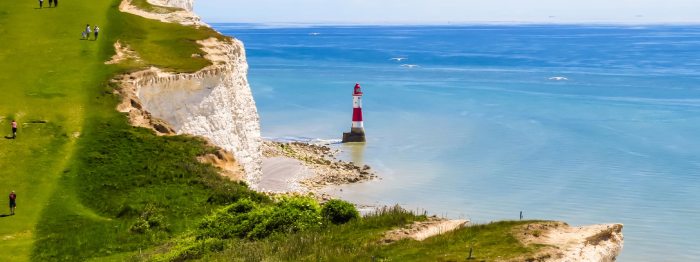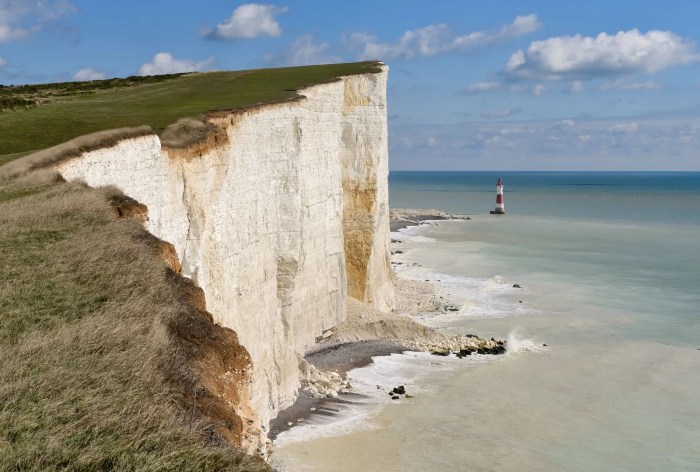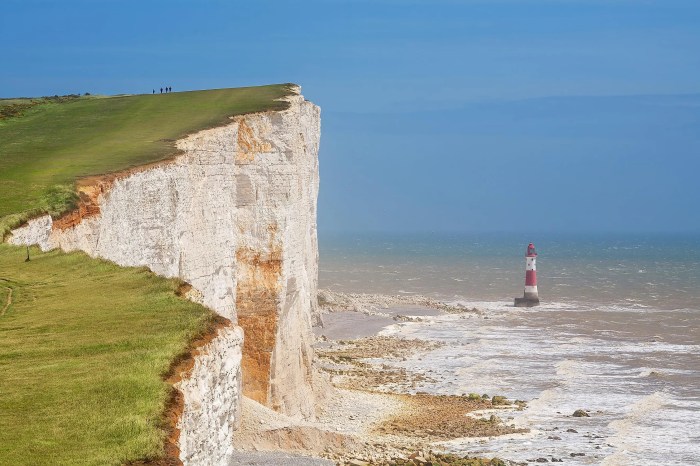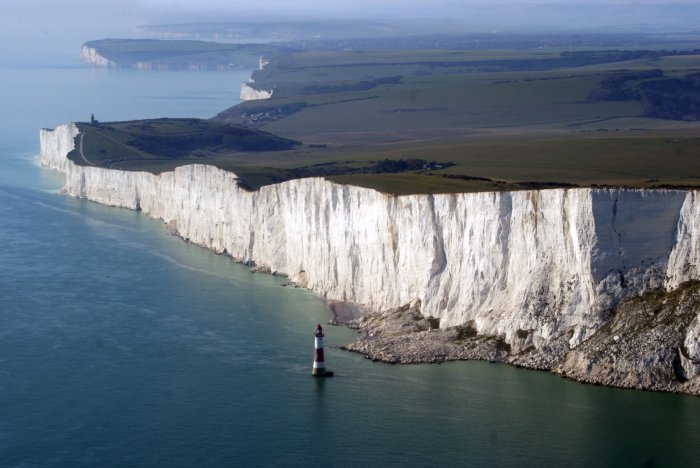Welcome to the captivating world of Beachy Head, an iconic landmark that beckons travelers with its breathtaking beauty and rich history. Perched atop the majestic white cliffs of East Sussex, England, Beachy Head stands as a testament to the power of nature and the enduring spirit of humanity.
As you embark on this literary journey, you will delve into the geological wonders that shaped Beachy Head, the maritime significance of its lighthouse, and the cultural legacy that has made it a beloved destination for centuries.
Beachy Head Overview

Beachy Head is a prominent chalk headland located in East Sussex, England. It forms part of the Seven Sisters, a series of chalk cliffs along the English Channel coast. Beachy Head is renowned for its dramatic white cliffs, which rise to a height of 162 meters (531 feet) above sea level. The cliffs are composed of soft white limestone, which has been eroded over time by the sea and wind, creating the iconic sheer face that characterizes Beachy Head.
Geological Formation
Beachy Head was formed during the Cretaceous period, around 100 million years ago, when the area was covered by a shallow sea. Over time, layers of sediment, including chalk, were deposited on the sea floor. As the sea level gradually receded, the chalk was exposed to the elements, and the cliffs began to form. The erosion process has continued over millions of years, shaping the landscape and creating the dramatic cliffs that we see today.
Beachy Head Lighthouse

Beachy Head Lighthouse stands tall on the chalk cliffs of Beachy Head, overlooking the English Channel. Constructed in 1828, it was designed by the renowned engineer James Walker and served as a crucial navigational aid for ships traveling along the treacherous coastline.
Architectural Features
The lighthouse is an iconic example of Regency architecture, featuring a circular stone tower with a distinctive black and white striped exterior. The tower is 103 feet (31 meters) tall and houses a spiral staircase leading to the lantern room. The lighthouse’s lantern emits a powerful beam of light visible for miles around, guiding ships away from the dangerous cliffs.
Role in Maritime Navigation
Beachy Head Lighthouse played a vital role in maritime navigation, especially during the era of sail. The lighthouse’s light helped ships determine their position and avoid the hazards of the coastline, preventing countless shipwrecks. In addition, the lighthouse served as a landmark for ships traveling between England and Europe.
Beachy Head is a breathtaking chalk sea cliff located in East Sussex, England. Its iconic white cliffs and dramatic scenery have made it a popular tourist destination. While Beachy Head is renowned for its beauty, it is also the highest chalk sea cliff in the United Kingdom.
Interestingly, the tallest mountain outside of Asia is aconcagua , located in South America. Aconcagua stands at an impressive 6,961 meters above sea level. Despite the vast difference in altitude, both Beachy Head and Aconcagua offer breathtaking views and are testaments to the diverse landscapes our planet has to offer.
Challenges Faced by Lighthouse Keepers
Lighthouse keepers at Beachy Head faced significant challenges due to the remote and exposed location of the lighthouse. The cliffs were prone to erosion and landslides, and the weather conditions could be harsh, with strong winds and fog. Keepers were responsible for maintaining the lighthouse and its equipment, as well as keeping a watchful eye for ships in distress.
Technological Advancements
Over the years, technological advancements have impacted the operation of Beachy Head Lighthouse. In 1983, the lighthouse was automated, eliminating the need for full-time lighthouse keepers. The lighthouse now operates using a rotating optic and a modern LED light source, providing even greater visibility and reliability.
Beachy Head as a Tourist Destination

Beachy Head is a captivating destination that attracts tourists worldwide for its breathtaking natural beauty and diverse attractions. Its iconic white cliffs, rolling green hills, and panoramic sea views offer an unparalleled experience.
Hiking and Walking Trails
Beachy Head boasts an extensive network of hiking and walking trails that cater to various fitness levels. The South Downs Way, a long-distance footpath, passes through the area, offering panoramic views of the coastline. Visitors can also explore the Birling Gap and Seven Sisters Country Park, renowned for their scenic walks and stunning chalk cliffs.
For a breathtaking seaside escape, Beachy Head beckons with its iconic white cliffs and mesmerizing views. Nestled among the world’s top luxury travel destinations , Beachy Head offers an unforgettable blend of natural beauty and coastal charm, making it a haven for discerning travelers seeking a luxurious and awe-inspiring getaway.
Birdwatching and Wildlife, Beachy head
Beachy Head is a haven for birdwatchers, with a diverse array of species inhabiting the cliffs and surrounding areas. Visitors can spot peregrine falcons, guillemots, razorbills, and other seabirds soaring through the air. The area is also home to various wildlife, including foxes, rabbits, and butterflies.
Photography and Art
The picturesque landscape of Beachy Head has long inspired artists and photographers. The dramatic cliffs, rolling hills, and expansive views provide endless opportunities for capturing stunning images. Visitors can take advantage of designated photography spots or simply wander the area to find their perfect shot.
Responsible Tourism
Recognizing the importance of preserving the natural environment, Beachy Head promotes responsible tourism practices. Visitors are encouraged to stay on designated paths, avoid disturbing wildlife, and dispose of litter properly. The area is actively managed to protect its delicate ecosystem, ensuring its beauty can be enjoyed by generations to come.
Beachy Head in Literature and Culture

Beachy Head has captured the imagination of writers, artists, and filmmakers for centuries, becoming an iconic symbol in British culture. Its dramatic cliffs, sweeping views, and tragic history have inspired countless works of art and literature, leaving a lasting legacy in the nation’s cultural landscape.
Literature
Beachy Head has featured prominently in English literature, serving as a setting or inspiration for many notable works. One of the earliest literary references to the cliffs appears in Shakespeare’s “King Lear,” where the character of Edgar contemplates suicide by leaping from their heights.
Beachy Head is a popular destination for hikers and nature enthusiasts, but it also offers opportunities for scuba diving. For those looking to explore the underwater world, scuba diving locations around Beachy Head provide a diverse range of marine life and underwater landscapes to discover.
From vibrant coral reefs to historic shipwrecks, there’s something for every level of diver to enjoy.
In the 19th century, Romantic poets such as William Wordsworth and Samuel Taylor Coleridge were drawn to the beauty and grandeur of Beachy Head. Wordsworth’s poem “Ode to Duty” includes a vivid description of the cliffs, while Coleridge’s “The Rime of the Ancient Mariner” features a scene where the mariner’s ship sails past the “steep and lofty cliffs” of Beachy Head.
Art
Beachy Head has also been a popular subject for artists, capturing its rugged beauty and dramatic landscapes. The 19th-century painter J.M.W. Turner created several iconic paintings of the cliffs, including “Beachy Head and Chain Pier” (1827) and “The Wreck of the Minotaur” (1835).
In the 20th century, artists such as Eric Ravilious and David Hockney have continued to find inspiration in Beachy Head. Ravilious’s painting “Beachy Head, Sussex” (1939) depicts the cliffs from a bird’s-eye view, while Hockney’s “The Blue Cliff” (1982) captures the vibrant colors and textures of the chalk cliffs.
Film
Beachy Head has been featured in numerous films, often as a backdrop for scenes of drama or tragedy. Alfred Hitchcock’s classic thriller “The Birds” (1963) includes a climactic scene where the birds attack a group of people on the cliffs. More recently, Beachy Head appeared in the film “The Remains of the Day” (1993), where it serves as the setting for a poignant scene between the butler Stevens and the housekeeper Miss Kenton.
Environmental Concerns at Beachy Head

Beachy Head faces several environmental challenges, including erosion, pollution, and climate change. Erosion, caused by the constant pounding of waves and wind, threatens the cliffs and the fragile ecosystem they support. Pollution from nearby towns and shipping activities poses risks to marine life and the overall health of the area. Climate change, with its rising sea levels and increasingly severe storms, exacerbates these issues and poses long-term threats to the unique ecosystem of Beachy Head.
Erosion
Erosion is a major concern at Beachy Head. The soft chalk cliffs are constantly being eroded by the relentless waves and strong winds. This erosion threatens the stability of the cliffs and the safety of visitors. In recent years, several sections of the cliffs have collapsed, and experts warn that more collapses are likely in the future.
Pollution
Pollution is another serious problem at Beachy Head. The area is affected by pollution from nearby towns and shipping activities. Sewage, agricultural runoff, and industrial waste can all enter the marine environment, harming marine life and damaging the ecosystem. Plastic pollution is also a major problem, with large amounts of plastic debris washing up on the beaches.
Climate Change
Climate change is also having a significant impact on Beachy Head. Rising sea levels are causing the cliffs to erode more quickly, and increasingly severe storms are damaging the infrastructure and threatening the safety of visitors. Climate change is also affecting the marine ecosystem, with changes in water temperature and acidity harming marine life.
Conservation Efforts
Efforts are being made to address the environmental challenges facing Beachy Head. These efforts include:
- Installing erosion control measures to protect the cliffs from further erosion.
- Reducing pollution by improving sewage treatment and reducing agricultural runoff.
- Raising awareness of the importance of conservation and encouraging visitors to take steps to protect the environment.
Final Thoughts

As we bid farewell to Beachy Head, we are left with a profound appreciation for its natural splendor and cultural significance. From its towering cliffs to its storied past, Beachy Head has captured the hearts and imaginations of countless individuals throughout history.
Whether you seek adventure, tranquility, or a glimpse into the past, Beachy Head offers an unforgettable experience that will linger in your memory long after your visit.
FAQ Explained
What is the height of Beachy Head?
Beachy Head rises to an impressive height of 162 meters (531 feet) above sea level.
Is Beachy Head a popular tourist destination?
Yes, Beachy Head attracts a significant number of tourists each year, drawn by its stunning scenery, historical significance, and recreational opportunities.
What activities can I enjoy at Beachy Head?
Visitors to Beachy Head can engage in a variety of activities, including hiking, birdwatching, photography, and simply soaking up the breathtaking views.